Besides grabbing the Spider Ball and Bomb, all there really is to do in the first little pocket of SR-388 is kill some alpha metroids and snag a few missile expansions.
This first area gives you a pretty good sense of how the entirety of Metroid II‘s structure works. Generally speaking, each separate breakout area consists of a large central structure crisscrossed with corridors and surrounded by something akin to the vertical shafts from the original Metroid. Multiple smaller corridors branch off from the perimeter walls of the main expanses. Basically, SR-388 contains several enormous caverns in which a huge central building has been erected, with small spurs leading to dead ends that generally contain a power-up or a metroid battle. These caverns are then connected to one another by the main path that winds through the underground, which is full of acid that gradually subsides as metroids die… for some reason.
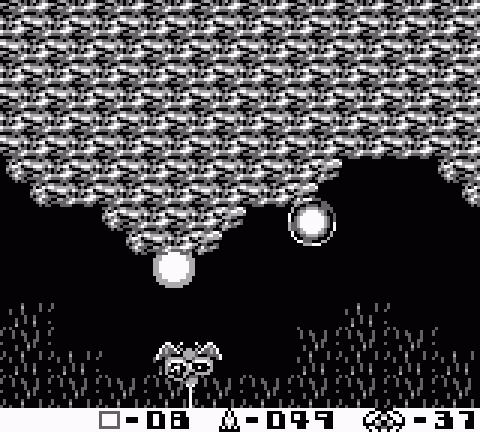
This design approach stems in part from the game’s cramped point of view. Because you can see so little of the screen at any given time, the levels must by necessity incorporate a less complex layout to minimize the likelihood that you’ll get lost. It’s fairly easy to pathfind your way around these breakout areas, because they mirror one another’s design and revolve around the presence of a large construct beneath an enormous open cavern. Once you stumble across one of those structures, you can easily make your way around its perimeter, delving into each offshoot corridor one by one to clear them out before returning to the central chamber, and then back to the main thoroughfare (once you feel the earth shake, of course).
Unfortunately, until you get the Space Jump — which, hilariously, isn’t actually that far ahead from this early point of the game — the most reliable way to explore the full extent of the central cavern is to use the Spider Ball and roll with agonizing slowness around the perimeter of the main chamber, taking care to avoid the various creatures that drift back and forth near the walls and ceiling; if they hit you, you’ll fall and have to start over. This is generally not much fun even if you manage to avoid being hit, and exploration really drags.
On the plus side, the game is pretty good about cluing you into the presence of secrets. Generally you’ll be able to spot missile expansions and energy tanks hidden in the walls, and the challenge becomes figuring out how to reach them. Sometimes it’s as simple as bombing a block nearby, but other areas are far more devious about it and will force you to approach from a different room entirely. It’s not perfectly executed, but Metroid II definitely demonstrates a growing canniness of the potential of integrating puzzle elements into exploratory level design. Unlike the previous game, you never need to bomb haphazardly to find passages to advance; the way forward is made far more obvious, even if you have to work for it on occasion.

Another nice touch is the use of discarded metroid husks to clue you in to the proper direction ahead. You’ll almost always find a molted shell near the junction of a corridor that leads you to a metroid battle — even, it seems, the ones where the metroid has yet to molt from classic to alpha form. Logic aside, this visual cue makes it much easier not only to brace for combat but also to navigate through the murky depths of the planet. Here, for example, you need to bomb those two boulders on the lower level in order to advance — something you might not think to do if not for the presence of the metroid husk to nudge your mind.
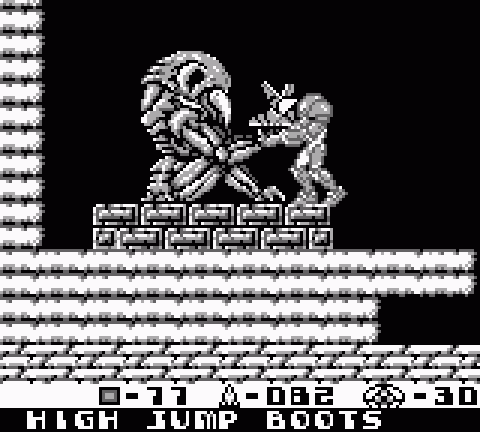
The second main area of the game contains the High Jump Boots. A major key to progress in a Metroid game, and already here it is. Again, Metroid II greatly front-loads the essential tools to navigating its world in order to emphasis simple combat over exploration. Acquiring the High Jump Boots makes traveling up those tall chambers much less of a hassle, though it does reinforce a severe shortcoming of the game: The short line of sight.
With the High Jump Boots in hand, you can jump higher than you can see. You therefore need to exercise this new power with caution, because there’s a good chance you’ll leap straight into a monster or other hazard unwittingly. This becomes especially frustrating in the vertical portions of the game, since the screen “leads” forward of Samus on the horizontal plane (the camera pans to put her about a third of the way toward the back edge of the screen, giving you more of a line of sight when moving forward) but not the vertical.
The constrained screen dimensions introduce another issue as well, though this may have to do with the Game Boy’s memory limitations: If you can’t see something, it doesn’t happen. If you drop a Bomb and scroll it off the screen, it disappears rather than exploding. If you fire at an enemy just off the edge of the screen, your bullets vanish even as the enemy continues tracking. When you clear vanishing blocks of sand, they’ll reappear once you scroll that space off the edge of the screen. Even more than the actual visual limitations, this makes Metroid II feel claustrophobic and sometimes frustrating.

The designers begin playing around with Metroid conventions here in the second phase. Here, you find a Chozo statue missing its usual item sphere, even though you’ve never been to this room before.
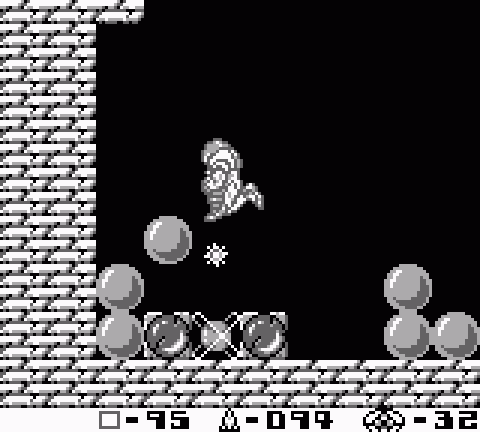
Turns out the sphere in question is in a storage space behind the statue. Shoot through a pile of identical orbs and eventually you’ll find the one you want, which contains the Varia suit to double Samus’ resistance to enemy damage. It’s an interesting piece of storytelling through design and layout and makes you wonder what happened. Did someone forget to put out the Varia before these ruins were abandoned? Or maybe before whatever apocalypse wiped out sentient life hit SR-388, they started to put their most valuable items in hiding?
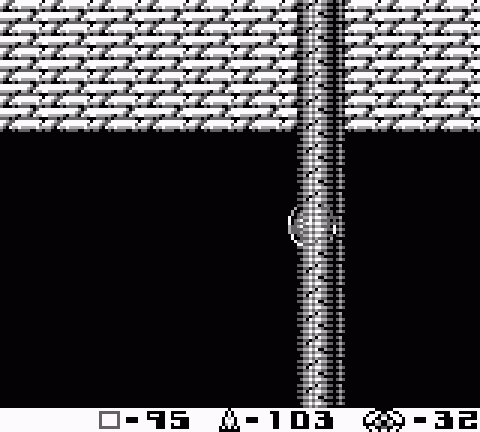
Another interesting trick: Layered environments. When you first pass this structure, it appears to be a non-interactive background element. But eventually you’ll come across the far end of it in the course of your exploration and discover that it’s a pipe through which you can travel, bridging a gap between two separate rooms by passing through a space you’ve already cleared in a different manner. This would be explored further in later Metroid games, but it’s a pretty clever trick.
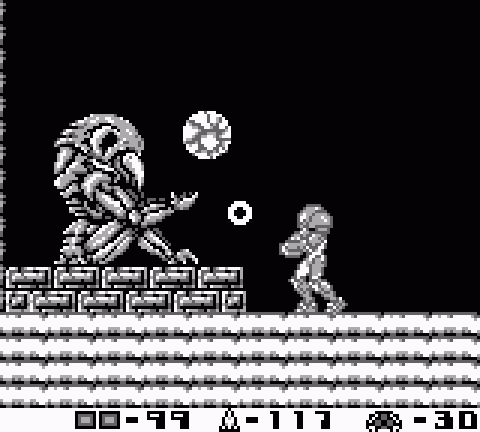
Speaking of trick, there’s also this Chozo statue whose orb springs to life when you shoot it. It’s a de facto boss battle.

The creature in question is like some sort of horrible armadillo that rolls around in its invincible shell and ducks into hiding the second you open fire on it. The only way to defeat it is to roll up into a ball yourself and leave Bombs in its path. This is the first mandatory use of Bombs in a Metroid game outside of freeing yourself from a metroid’s clutches, so it may throw you for a loop until you can figure out how to damage the creature indirectly (the fact that the creature begins as a ball and constantly rolls into a ball is a helpful clue). Once you triumph, though, you receive the Spring Ball, which makes getting about in Morph Ball form much more convenient. You can now jump in ball form — no more relying on Bomb-jumping.
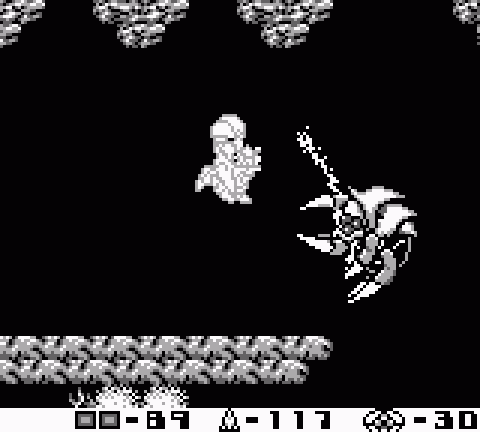
And the final surprise of phase two: You meet your first gamma metroid. (There are no beta metroids; I guess they all died off after being friend-zoned, because they were such Nice Guys that lady metroids didn’t want to get with them.) The gamma mutates from the alpha — a process you witness first-hand a few times, because the metroids are considerate enough to wait until Samus shows up before evolving, which makes it clear to the player that, hey, this is one of those things you need to blow up.
Gamma metroids definitely resemble alphas — you can see the eyes and central body orb — but their claws have begun descending to somewhat resemble bipedal limbs, and a hard shell is emerging from the base of what appears to be adapting into its head. In terms of combat, though, the important thing is that a gamma metroid takes 10 missiles to destroy, not just five, and it features an electric attack that can both damage Samus and deflect incoming fire. Its body is also more resistant to attacks, and you have to aim carefully at its exposed underbelly to score the most damage.
Not every metroid you’ll face from here on out will be at gamma level; there’s even a lonely alpha in the very final batch. But this is definitely your sign that you need to get serious about finding more missiles and track down the Varia Suit if you haven’t already. The threat level of your enemies grows considerably from this point.
I do love how they use those discarded metroid husks. It really makes you feel like you’re hunting them down, even though they never move from room to room.
I also never realized just how much the game front loads the upgrades, but your right. You do get most of the really good stuff early in the game.
I am really glad you do not go down the same path you went in your past 1 UP review of Metroid 2: You promised to be fair and so far you have kept your promise, great! While I do not find everything you critize bothersome, I can see how you or others might. There are definately some aspects that are rather rough around the edges. Personally, I find most of them oddly charming. Probably this is mostly due to nostalgia or the fact, that despite its relative linearity, there is no actual handholding. This made the (subliminal) learning process of the surroundings and finding secret areas a lot more satisfying to me - even finding the ones that do not contain any collectibles and probably only exist because of some odd programming based on memory restraints.
I found this retrospective to be a lot sharper and more accurate, than some of your recent reviews at US gamer (e.g. the Super Castlevania VC review was unfortunately too unbalanced and nitpicky). You really seem to put a lot of thought into these retrospetives and the result is an informative, yet amusing and enjoyable read.
I meant “criticize”, not “critize”
While I’ve never gone back to it (maybe I should?) I think you’re doing a great job here of striking a balance between pointing out Metroid II’s egregious shortcomings and its new developments or clever adaptation to limitations. For a game released two years after the Game Boy, it seems pretty daring; do you intend to compare it to its contemporaries during wrap-up?
I wonder if they skipped beta because the first game established that Metroids multiply when exposed to beta rays for twenty-four hours, and they didn’t want to risk confusing anyone.
Really digging this edition of “Anatomy of.” Metroid II is the only 2-D game of the series I’ve never really delved into, so getting a second-hand experience with such in-depth analysis is great.
Also, that beta joke? I dunno, man…
Aw, c’mon, if you can’t make fun of sulky Internet manbaby sexists, who can you make fun of?
Sometimes I think of the simpler layout of the “stages” of this game as an almost ironic counterpoint to the insanely convoluted way the level data is arranged internally. A complete map of SR-388 makes the game look more complex than it actually is, but viewing the arrangement of things from a level editor makes you wonder if their heads were even screwed on straight.
What I’m saying is that the TAS that uses the secret world glitch is glorious and unfathomable: http://tasvideos.org/1175M.html
I remember in my first playthrough back in the day, I finished the game without ever encountering that mid boss and getting the spring ball upgrade… I didn´t even felt I had missed something! Its odd how they made that power up just be there out of the way and not really necessary to advance in any way… There´s no place the spring ball will take you the spider ball can´t.